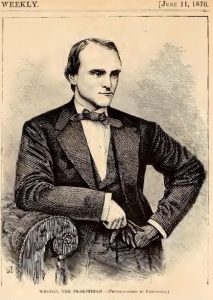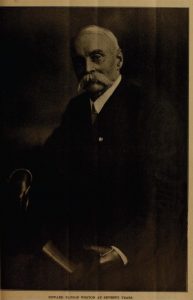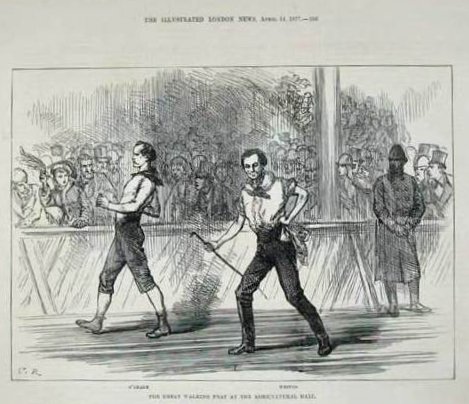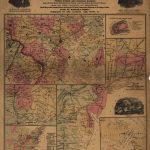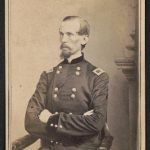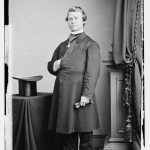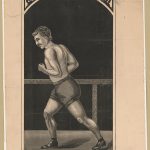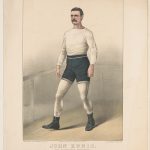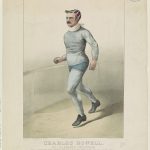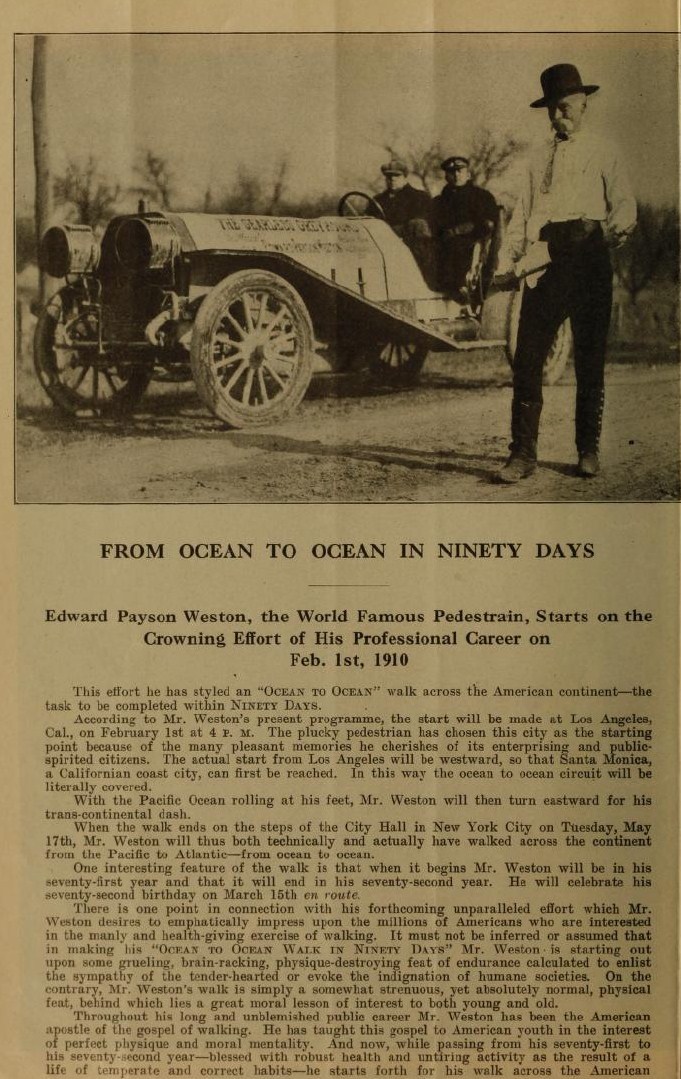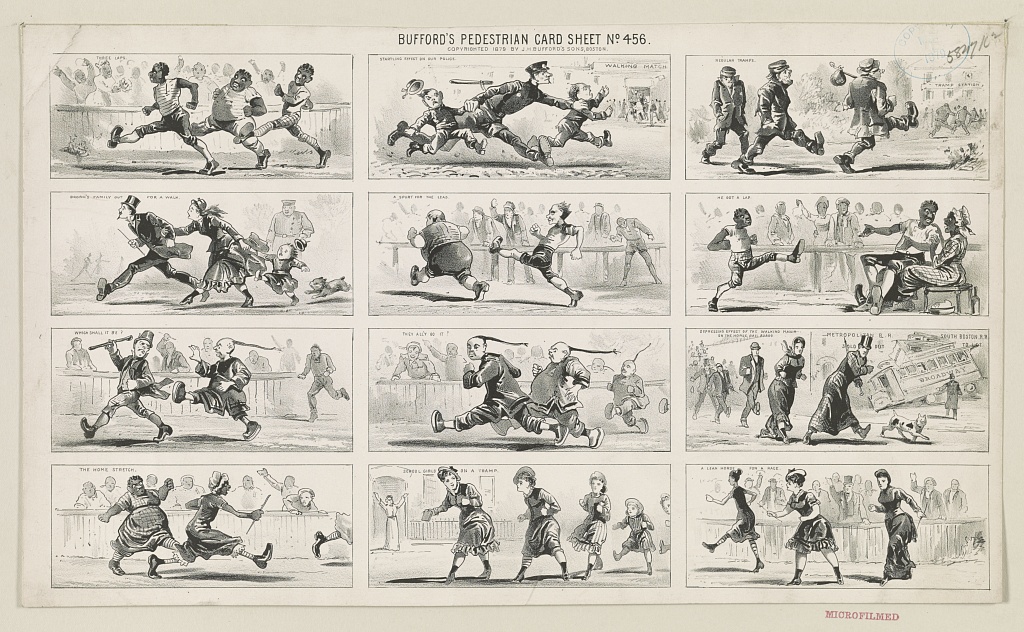Here’s a man that might have fit right in with Stonewall Jackson’s foot cavalry – except that he hailed from north of Mason-Dixon.
From Harper’s Weekly June 11, 1870:
WESTON, THE PEDESTRIAN.
WE give on this page a portrait of Mr. EDWARD PAYSON WESTON, the well-known pedestrian, who has just accomplished the feat of walking one hundred miles in twenty-one hours and forty minutes – twenty minutes less than the time required by his wager. The performance took place at the Empire Rink, in Third Avenue. He made about nine stoppages for rest during his walk, none of which was longer than ten minutes. His chief nourishment was beef-tea, together with crackers, raw eggs, and lemonade. He accomplished the one hundred miles without giving evidences of any great strain on his mental or physical system, being nearly as fresh at the finish as he was at the opening. The first fifty miles were made in ten hours and thirty-five minutes. His quickest mile was done in about eleven minutes, and his best single circuit of the rink in one minute and twenty seconds. The close of his performance was witnessed by an audience of at least 5000 people, who greeted his triumph with enthusiastic applause.
5000 people crowded into a building for a sporting event? What were they thinking?
You can learn more about the Empire City Skating Rink (and see a picture) at Daytonian in Manhattan. Mr. Weston isn’t mentioned, but: “The building continued to be home not only of the annual fairs, but of athletic events and other spectacles. In the spring of 1877 a five-mile walking race took place here.”
Edward Payson Weston was a life-long long distance walker. An article at the Running Past website begins with his famous 1861 walk from Boston to Washington, D.C. to honor a wager: If Abraham Lincoln won the 1860 presidential election, he would walk the 478 miles in ten days to attend the inauguration. But that was just the beginning of some amazing feats, only ending when Mr. Weston was a septuagenarian: After a couple coast-to-coast walks at 70 and 71-72, “His last big hike was in 1913 at age 74, from New York to Minneapolis.”
Matthew Algeo, author of Pedestrianism – When Watching People Walk Was America’s Favorite Spectator Sport, in an interview at NPR, said that mass urbanization after the Civil War created huge numbers of people with a good deal of time in their hands, “so pedestrianism — competitive walking matches — filled a void for people. It became quite popular quite quickly.” Mr. Algeo mentioned Edward Payson Weston and one of his great rivals Dan O’Leary and compared them to Muhammad Ali/Joe Frazier. O’Leary was like Smokin’ Joe – quiet, serious, and focused on the competition. On the other hand, “Weston was a flashy guy. He wore ruffled shirts and sashes and capes and carried a cane … he really understood that it was about entertainment as much as it was an athletic event.” The NPR article shows a drawing of Weston walking in 1874 in a ruffled shirt and high boots.
___________________________
Self-promotion might have added to the entertainment value. E. P. Weston wrote several books/pamphlets about his exploits, beginning with his 1861 walk to Washington for the Lincoln inauguration. The Pedestrian; being a correct journal of “incidents” on a walk from the state house, Boston, Mass., to the U.S. capitol at Washington, D. C. … between February 22d and March 4th, 1861 is available at HathiTrust. The book also includes his time-table for a planned May 1862 eight day walk from Washington to Boston and an account of a journey that began in late April 1861. Dressed in a disguise furnished by Brooks Brothers, Mr. Weston delivered mail from New York City and Boston to soldiers and officials in the Annapolis and Washington D.C. area. The missives were also disguised: “These letter’s being confined in an enameled cloth bag, furnished by the Rubber Clothing Co., which was sewed into my clothes.” Unsurprisingly, much of the trip was by foot from Philadelphia. He didn’t have any real trouble in a riled up Baltimore: “Passing through the city at that late hour, I observed a motley crowd on almost every corner, and did not feel inclined to make any longer stay in Baltimore at that time, although but a few weeks previous [before Fort Sumter and the Baltimore riot of April 19th] I had been kindly entertained by a number of the citizens on my way east, after having walked to Washington [for the Inauguration].” As Mr. Weston approached Annapolis he was detained for over a day and half by the 69th New York Militia. For part of that time he was held in the “guard-house, a nasty, filthy place, about ten feet square, wherein were confined three or four of their own men. I thought it was an elegant place to invite a man into who had walked seventy miles in less than twenty-four hours, and who needed at least a decent place to sit down in. But I had to ‘go in and bear it.'” Finally the 69th’s Colonel Michael Corcoran and it’s chaplain Father Mooney interrogated the pedestrian, examined the letters he was carrying, and telegraphed the Howard Hotel in NYC for a reference. The 69th released Weston after receiving a good word from the hotel. He successfully completed his mission and met General B.F. Butler in Annapolis.
According to King of the Peds “Pedestrianism hit its zenith in 1879.” The documentation at the Library of Congress says the three card-type images below and the big group picture at the bottom were all published in 1879. Weston, O’Leary, and Rowell are all candidates for the title of champion at the King of the Peds.
You can read all of Harper’s Weekly for 1870 at the Internet Archive. I got the image of the 1877 London duel from Wikimedia.
From the Library of Congress: walking groupies; 1861 Seat of War; General Michael Corcoran; Father Thomas Mooney – according to Irish in the American Civil War “Father Mooney would get into hot-water during the militia’s time at Fort Corcoran for blessing an artillery piece, an action that led to his recall.”; generic pedestrian; John Ennis Charles Rowell.

